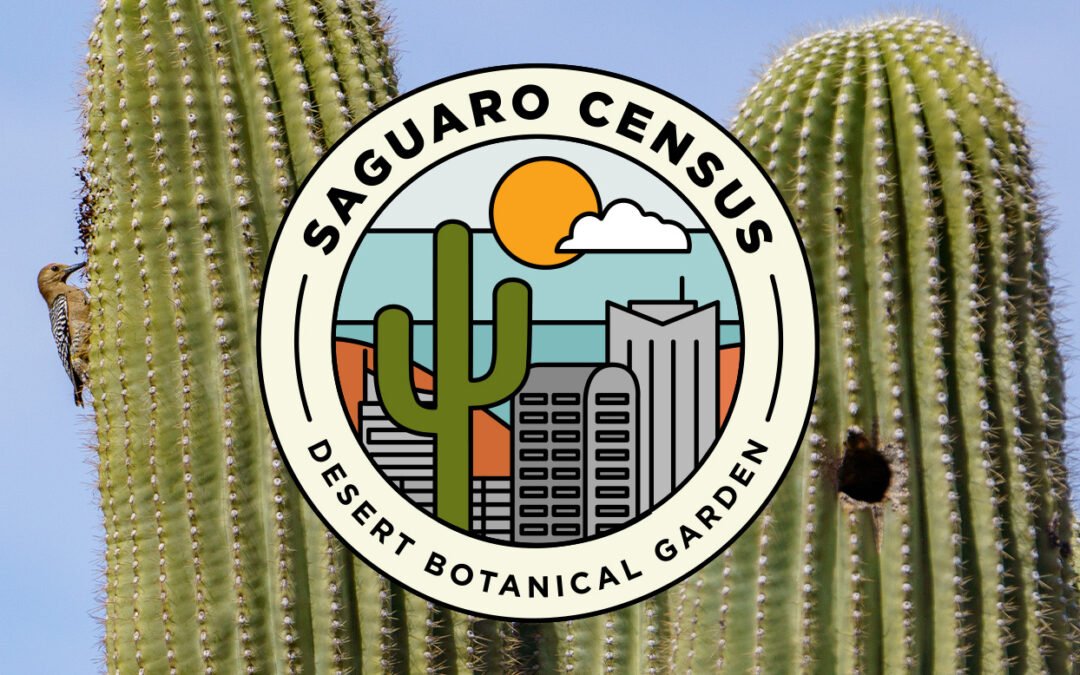Desert Botanical Garden’s Saguaro Census recorded 3,670 saguaro observations across metro Phoenix in May with the support of Valley residents and volunteers, expanding its total number of observations to more than 19,000 since the project’s launch in 2022.
As of June 21, 2023, there have been 19,057 saguaro observations in the Phoenix area recorded on iNaturalist, a free app that allows users to share and map observations of biodiversity. These figures are already helping Garden researchers uncover more details about the Valley’s iconic yet elusive urban saguaro population.
This past year, Garden scientists collected samples of homeowners’ saguaros to analyze the plant’s DNA sequence. This is part of a larger project — Saguaros Under Stress — led by the Garden’s New World Succulents Specialist Dr. Tania Hernandez to understand the stress effects that extreme can have at the molecular level.
Now more than ever is it critical to understand how heat stress is affecting plants and urban saguaros are a particular concern to Garden scientists.
Phoenix experienced 31 consecutive days with temperatures of 110 degrees Fahrenheit or higher this past month, smashing the previous record set in June 1974, when the city had a streak of 18 days. Throughout the Valley, many plants are yellowing and wilting, residents are reporting saguaros that have fallen down or had arms fall off, and some plants are dying.
“It is really disturbing to drive around the Valley and witness so many plants dying. Young plants and succulents like agave or cactus are suffering the most. Saguaros are shrinking, leaning or loosing arms. It is really frustrating because without rain, and without typical monsoon cloudy skies to cool down the temperatures, plants are overheating and drying,” Hernandez says.
The Garden launched its first-ever urban Saguaro Census on May 2022 to track and document the health of saguaros with support from Valley residents and volunteers. The census was created in response to community concerns of saguaros that had collapsed or lost arms during the summer of 2020.
This year, nearly 200 Valley residents and volunteers participated in the Saguaro Census during May, with the most observations made in north Phoenix, southeast Phoenix, Tempe and Sun City.
Of the 3,670 observations made in May, 395 were repeated saguaro observations, from plants that were observed the previous year — the majority, or 257, were reported to still have been in good health. Five of those observations reported saguaros that had fallen down, three that had brown spots, two had lost arms, four were leaning and only one had been gone (possibly died between the time the two census projects took place).
Overall, the Saguaro Census recorded 985 observations of saguaros in good condition from participants who added health observations. Some 248 saguaros were reported to be in fair condition, and 82 were in poor condition. Saguaros reported to be in poor condition include sun damage, rot, freeze damage, multiple types of damage, human damage and other observations.
Saguaros located near schools and in residential areas were observed to have the least damage. In commercial area, participants observed some damage on saguaros, including from the sun scorch and rot, but the majority did not have any damage at all.
Participants also shared height information. This year’s Saguaro Census recorded 424 large saguaros (plants larger than 16 feet), 825 medium-size saguaros (between three to 16 feet) and 68 small saguaros (less than three feet).
“Again, this year we confirm the lack of young saguaros. When our old and weak ones die, we won’t have a replacement cohort. When I see people concerned about saguaro health, sometimes I recommend: let’s plant more saguaros! Let’s also plant trees and bushes and agaves. We can expect temperatures to keep rising, and plants to die. We need to get ready,” Hernandez says.
In May, the Garden also asked participants to document saguaros that are highly stressed or dead by filling out a short online form about the cactus. With more reports this summer from residents of fallen saguaros or ones that have lost arms, the Garden is again asking the community to fill out the form to understand the health and demographics of urban saguaros.
The form includes the age, location, estimated size and possible cause of death.
As for additional plant care tips, Hernandez recommends a few to keep homeowners’ saguaros healthy this summer.
“I receive so many emails from the community asking me what to do about their stressed plants, and my only advice is to try to provide shade to the small ones, and try watering and showering the large ones, particularly at night. However, nobody knows if this is actually going to work. Even with supplemental irrigation, we are losing many plants here at the garden,” she says.
The showering is to provide water but also to help the plant cool down, especially when temperatures are at the highest in the late afternoon and at night.
“This could allow to stop the tissue damage, but also allows adequate temperatures so the plant can keep doing photosynthesis and basically being alive. Photosynthesis, particularly for succulent plants, would arrest at high temperatures, particularly high night temperatures,” she says.
For more details about the Saguaro Census and how you can get involved visit dbg.org/events/the-metro-phoenix-saguaro-census-2023/ or email saguarocensus@dbg.org.
